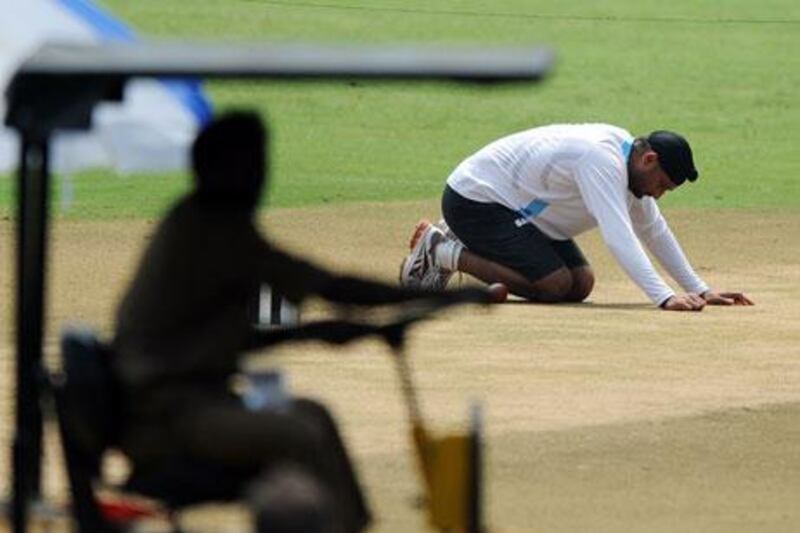After a second successive draw against New Zealand 12 months ago, MS Dhoni gave vent to his frustration about the state of pitches in a country once renowned for the exploits of its slow bowlers.
"As a foreign team coming to India, you think of how you're going to play the fourth and fifth days," he said. "But when there's no assistance for the bowlers, things change.
"I don't think they're under the same pressure when handling spinners that they were in the past. You used to see them practise throw-downs on scuffed surfaces with rough areas. I don't think it's like that any more.
"Of the Test matches we've played lately, very few have been on turners. I can remember Ahmedabad against Sri Lanka [2005]. After that, Kanpur [2008, against South Africa] to some extent. The CCI [Cricket Club of India] wicket in Mumbai [against Sri Lanka, 2009] also gave a bit of assistance in the morning."
That three-game series against New Zealand saw Harbhajan Singh finish top of India's batting averages, inclusive of two centuries. With the ball, he had just 10 wickets. Pragyan Ojha took 12.
Last Saturday, after the dramatic last-ball draw against West Indies in Mumbai, Dhoni reiterated his desire for pitches that cater to India's traditional strengths. "I want the pitches to turn from the very first day," he said, after 17 wickets had fallen in the final three sessions.
"It sets off a bit of panic in the opposition's dressing room and, at the same time, you [India] are under pressure to perform as well. That's what makes it interesting."
Dhoni's candour was refreshing in an age when spin-friendly surfaces are frowned upon. When an English captain lauds a pitch that gives his bowlers appreciable seam movement, no one bats an eyelid. When Australia go into a Gabba Test with an all-pace attack, visiting teams accept that it's a Labour of Hercules that they have to overcome.
Prepare a pitch that takes turn from day one though, and chances are that the match referee will be all over you like a loose forward in a rugby maul. And while most teams whine, subtly or otherwise, about the surfaces that confront them in India, Darren Sammy proved to be an exception.
"It did bounce and turn more than on all the previous four days, but it was nothing that we shouldn't have been able to handle," he said.
It certainly wasn't a pitch on which two international sides should lose 17 wickets in a day, just as the surface at Newlands was nowhere near as bad as South Africa and Australia made it look while being skittled for 96 and 47 on the same day of a recent Test. But with batsmen looking to seize the initiative rather than show some patience, bowling attacks are never out of the game.
That said, there is a reason Indian pitches do come under scrutiny. In recent times, there have been a spate of games that do nothing to maintain interest in the five-day format, matches played out on placid surfaces that were ideal candidates for nine-day Timeless Tests.
In the last decade, India has seen 20 draws in 50 Tests. In the same period, there have been just eight draws in the 58 games that Australia has hosted. Even the spinners have struggled, with the abject lack of bounce on offer making it hard for bat-pad catches to come into play.
When Harbhajan lashed out at the surfaces used against New Zealand last year - "He deserves to be given the contract to build national highways," he said of the Hyderabad curator - it was written off as the rant of a bowler on the wane.
A year on, Ravichandran Ashwin was man of the series for his 22 wickets. But that didn't stop him expressing his dismay at what he had to work with. "You can't expect the wicket to turn on the first day of a Test match," he said. "But you do expect some bounce. This game, I was definitely expecting some bounce. So I felt cheated in that regard."
Had such a statement come from someone who had a poor game, it could have been brushed aside. But Ashwin finished the match with a century and nine wickets, falling just short of a double that only Ian Botham and Imran Khan have managed in the game's long history.
At lunch on the final day, after West Indies had lost their last eight wickets for 43, Sunil Gavaskar - whose final act in Test cricket was a magnificent 96 on a cabbage patch in Bangalore - was joking about how some modern-day batsmen would have fared on the raging turners that defined Indian cricket in his era. In his pitch report before play started on the final morning, he had mimed falling asleep because he felt it was that benign.
But as at Newlands, batsmen were the architects of their own downfall. For Harbhajan, reduced to onlooker status for the Australia tour, that will be no comfort. Even without much assistance from the pitches, Ashwin and Ojha took 42 wickets between them, bowling India to the brink of a series whitewash.
Dhoni's request for more "Indian" pitches is unlikely to be granted in future. But perhaps for the first time in his captaincy, he has a bowling unit capable of surmounting the conditions, regardless of whether they feel cheated or not.
Follow
The National Sport
on
[ @SprtNationalUAE ]
& Dileep Premachandran on
[ @SpiceBoxofEarth ]





